Thursday, December 13, 2007
More on the Homebrewer's Recipe Guide...
Like my previous batch, this one is based on a recipe from the "Homebrewer's Recipe Guide", specifically the "Maura's Bride Ale". IIRC, the bill was:
3 1/3lb light extract
3 1/3lb amber extract
1lb Honey
1/2 lb Crystal Malt (20L)
2oz Willamette Hops (bittering)
1oz Liberty Hops (flavor)
1oz Cascade Hops (aroma)
1oz Cascade Hops (dryhop).
Everything went pretty smoothly in the brew process (I even had the chance to work on a cool papercraft project someone gave me, which hopefully I'll finish soon, so I can post a picture), but unfortunately, I'm not sure how well it'll turn out.
When I pitched the yeast and got fermentation going was right around when it warmed up this week, and I think that may have screwed up my beer.
The temp strip I have on my fermenter wasn't registering, so my fermentation took place above 78deg F. (that's the highest the scale goes) So, if it tastes like bananas (esters), I won't be surprised. I read somewhere that a long secondary ferment can lessen that flavor element, so maybe if I just let it sit in the secondary for a long time (2-4 weeks, maybe?), it'll be ok. I'm moving it to the secondary this weekend, so I'll know soon enough.
But anyway, even though this batch may not be perfect, I have to say the book I'm working with right now is pretty close to perfect. The recipes are clear and concise, and are mostly extract recipes, since the authors claim that some 80% of homebrewers (including me) brew primarily extract beers. It's nice to have a recipe guide that aims to meet your needs.
I actually own another book by the authors, called "Secrets of the Master Brewers". I've never made any of the recipes in there, but it was a good read, and it turned me on to a lot of fine breweries.
Monday, December 3, 2007
What I'm reading now...
World War Z, an Oral History of the Zombie War, which is actually a lot better than the name implies.
My current technical book is
Programming Erlang, which is a tutorial on Erlang, a functional programming language developed by the people at Ericsson.
Bubble, bubble...
The Homebrewer's Recipe Guide. One thing led to another, and I decided to work off a recipe in there, specifically the "Jack the Ripper British Ale".
Their original recipe is:
6 2/3 lb light malt extract
1/4 lb crystal malt
1 oz Hellertauer hops (boiling)
1/2 oz Tatinger hops (aroma)
1 oz Hellertauer hops (dry hop)
2 tsp gypsum
1 tsp irish moss
Working with what I had on hand, I went with:
1/2 lb of Caramel malt (instead of 1/4lb crystal)
1 oz Cascade hops (boil),
1/2 oz of E Kent Goldings, 1/2 oz Willamette (aroma)
I'm going to stick with Hellertauer hops for the dry hop, though.
What I'm hoping I'll end up with is something with good body (my last beer elicited more than one comment about being really good, but lacking in body), and a good hoppy aroma plus some bitterness.
I'm going to be waiting at least 2 weeks (1 week initial ferment, 1 week secondary ferment) to taste it in flat form, but hopefully it'll be a good one!
Sunday, December 2, 2007
Quiet too long...
Anyway, I plan to make up for it, hopefully with several new posts today and in the following days.
First on tap, I'll be brewing today. I've got 5 lbs of liquid malt extract, several ounces of hops, and several varieties of loose grain from my freezer that I probably should use up (if they're not already bad), so I'm going to see if I can't take a base recipe (Wise Ass Red from Papazian's Joy of Homebrewing) and make it my own.
So here's what I have:
5 lbs amber liquid malt extract
2 oz Cascade hop pellets (alpha 5.1)
1 oz Hellertauer Hops (alpha 2.5)
1 oz E Kent Goldings hops (alpha 6.0)
1 oz Willamette hops (alpha 3.7)
1 lb caramel malt
1/2lb chocolate malt
Looking at this, and what I want to make, I think I need to make a quick trek to the brew store for more malt extract (and those grain bags to hold the hops/grain.)
Stay tuned!
Friday, October 19, 2007
Sleater-Kinney....
Thursday, October 11, 2007
Bottling...
Bottling is probably my least favorite part of the whole brewing process. It's tedious, time-intensive, and generally not a lot of fun.
Here's how my bottling process went:
- I started by taking my ~2 cases of bottles that I had (a mix of Saranac, Sierra Nevada, and Carolina Brewing Co bottles), and soaking them overnight in a cooler filled with water (and a small amount of iodophor).
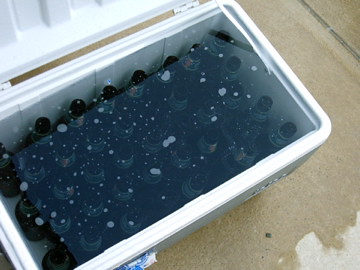
- Then I scraped all the labelling off of the bottles. I do this for two reasons. One, I think a blank bottle looks better than a repurposed Saranac or Sierra Nevada bottle. Two, I sterilize my bottles in the dishwasher, and the labels will come off in there anyway, and I worry about that paper clogging up the dishwasher.
- After scraping, the bottles go in the dishwasher for cycle of "hottest dishwasher setting". This gets them sterilized.
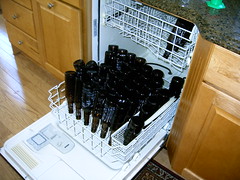
- While that's going on, I get the beer out of the bathtub where it's been patiently waiting, and I take a hydrometer reading to make sure my alcohol content is where I want it.

- Assuming that the beer's ready, I make up a sugar solution of ~1 cup corn sugar plus 2 cups of water (about). This is my priming sugar, and will get mixed into the beer just prior to bottling. Without this, we're drinking flat beer, and frowning while we do it. Once that's done, I transfer the beer from the "fermentation vessel" to my "bottling vessel", mixing in the priming sugar. (Basically, I move it from one bucket to another). I also take my bottle caps and soak them in a solution of "Beer Brite". I don't know what the correct chemical name is, but it's supposed to sterilize them.
- So now, we've got bottles that are ready, caps to put on them, and beer that's been primed. We're ready to go. I like to use the dishwasher to set the bottles on while I'm filling, because it makes less mess. You're inevitably going to get beer spillage, and it's much easier to just close the dishwasher and let the runoff go in there, rather than having to mop the floor.

- I process the bottles in batches while I bottle, filling and capping 12-18 bottles at a time (since I am trying to be somewhat paranoid about cleanliness). Unfortunately, I didn't get a picture of the actual capping (you're not missing much, though). But, I did get a pic of filling:
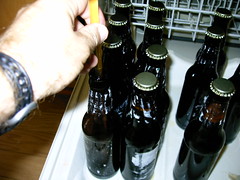
If you squint, you can see that my left hand is holding the filler. - Finally, after 50 bottles, you end up with this:
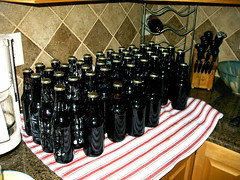
- The last step of bottling (other than cleaning up) is just waiting. Once the beer's in the bottle, it has to wait 7-10 days more, so that the priming sugar can generate CO2, and that gas can infiltrate the liquid and carbonate it. However, once it's going into the bottles, it is beer (just flat), and you can get an idea of how it looks, tastes, etc. Here's my beer's glamour shot:
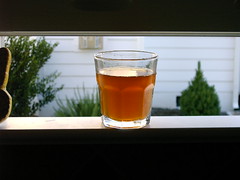
And there you go. That's how I bottle, and that's why I'm planning on starting to keg my own beer. It's just seems like it'll be simpler (less to clean), and I think it's faster, too, since it's probably faster to carbonate the beer in the keg than in bottles. I guess that'll be my next post, pricing out how much a keg system will cost.
Wednesday, October 10, 2007
Calculating alcohol content...
Looking online, I found this formula at 'How Stuff Works',
which is basically (Original Gravity - Final Gravity) * 1.05/Original Gravity.
In my case, I screwed up and forgot to write down my original gravity. I think it was 1.062, and I had a final gravity of 1.010. Applying the formula, that works out to:
(1.062 - 1.010) * 1.05 / 1.062 = .052 * 1.05 / 1.062
= .0514
In other words, 5.14% alc. in my beer.
Rather than doing that math every time, I should really throw a bit of javascript up to automate this.
Tuesday, September 25, 2007
Catching up....
I was a little busy last week, since my car paid the ultimate price for our trip to Asheville. The day after we returned, I noticed that my car (an Audi A4) was severely down on power, so I took it in to the dealer to get it looked at. The diagnosis: "need a new turbo and exhaust manifold, and by the way, you're leaking a little oil, so you probably should get your gaskets on the camshaft cover replaced". Total estimate: $3400 (!).
As much as I loved my A4 (and I thought it was a great car), I just couldn't spend more money on it, especially after replacing the timing belt, the front suspension, and the ABS computer. So, I sold it on craigslist, and used the money for a down payment for my new car (a Toyota Matrix). It's nowhere near as sporty, and it's not as fancy as the Audi was, but it's more practical, with more room and better mileage.
Other than that (and my so far failed attempts to get adsense working), not a lot going on at the piney grove (home)brewery...
Thursday, September 13, 2007
Asheville, Day 2...
The house was interesting, principally for the Gilded Age perspective it provided. Every room in the residence was large, overdecorated (to my tastes), and extravagant. By contrast, the servants' quarters were quite spartan. In the basement, there was a pool, bowling alley, weight room, the whole nine yards. It really brought home the divide between rich and poor that existed back then.
The really striking part of Biltmore, for me, is the grounds. The landscaping was designed by Frederick Law Olmstead, who also designed Central Park and the landscaping for the Chicago World's Fair. I doubt that Central Park was as elaborately designed as Biltmore, and it's probably not a faithful representation of Olmstead's vision by now anyway (I've never been to Chicago, but I'd be willing to bet that if anything remains of the White City, it probably doesn't represent his vision anymore either). I feel pretty confident, though, that Biltmore does remain faithful to his vision to a large extent, and it's a really good opportunity to see how good of a landscape architect he was, especially for his time.
I'm not sure how much earth-moving equipment was around back then. I guess labor was cheap enough that you could just throw labor at a problem.
After several hours at the main residence (and after serious sticker-shock over the prices for food and souvenirs), we decided to head over to the winery that they have. We were lucky, in that we showed up just in time for the "behind-the-scenes" tour. If you're ever at a winery, and you have the chance to take a tour like that, I highly recommend it. It's interesting to see how something as common as wine is made, and especially how industrialized the process is. In the back of my mind, I always had this vision of a very rustic enterprise, with a bunch of nuns stomping on grapes in the back room. I knew that wasn't realistic, but I certainly didn't expect a factory, with gigantic stainless steel fermentation vessels and the like.
Anyway, after the tour, we tasted some wine. My only comments with respect to wine would be, it seemed only so-so. I think you can get better wine for the same price, or cheaper, pretty easily. At the price point Biltmore appears to be at (~$10-$15, it seemed), you can get a better California wine, and for less, you can certainly find good (and better) South American wines.
But, I suppose they get some business from the name, and some from the local connection, and people at the winery are probably also buying for the souvenir value.
To close the book on Biltmore, I thought it was pretty cool. The only thing I really didn't care for was the cost of everything. I understand that it's a private enterprise, and a house that size certainly costs money to keep up, but sheesh, the prices for everything were high, and the naked capitalism really kind of clashed with the elegance of the estate. Although, I guess it shouldn't, since it's in keeping with the Gilded Age.
After Biltmore, we went driving on the Blue Ridge Parkway, looking for Mt Mitchell. We didn't make it there, but we did decide to go hiking on a trail we found at the Craggy Garden (I think that was the name of it) picnic ground. It was a fun trail, and at the top was a beautiful view.
When we got back to Asheville, it was getting close to dinner time. So, after a short rest, we headed out to Salsa's, a mexican/caribbean restaurant that Liz had read about on the internet. We had ceviche and chips with an avocado-tomatillo salsa to start. For the main course, I had lamb enchilada's, and Liz had an empanada. We didn't have anything for dessert, because we were stuffed by that point. Overall, if you're looking for a good meal, it's a good bet. (Even though they have a limited selection of micro-brews).
Wednesday, September 12, 2007
Back from Asheville
(even though I did miss our daughters).
Anyway, we drove up on a Sunday, arriving around 2:30ish, which was just in time to check into our hotel, the Haywood Park Hotel. I believe it used to be a department store. All this really signifies is that the rooms are pretty good size, and our room, which was pretty reasonably priced, was huge, with a large sitting area and a bay window overlooking the street.
After we got settled, we decided to go check out Asheville proper. Since we were right in the middle of town, this was easy to do. First we crossed the street to the Woolworth Walk, which is an art market in a converted Woolworth's department store. The website says 150 artists, and I can believe it. I picked up a really cool picture of a dragonfly that's going on my reading room wall, once I get a frame for it. As luck would have it, we also noticed an ad for the "LAAFF" (Lexington Ave Arts and Fun Festival). After walking around downtown a little bit, mainly scouting out locations for dinner (and checking out the Jack of the Wood, which serves Green Man beers, although I didn't get the chance to try one), we headed over to the LAAFF.
It turns out it was a street festival along what I guess you'd describe as a "hipster street". They had juggling, music, arts, jewelry, etc, and a very high "alternative" factor. I joked to Liz that if we ever moved to Asheville, I'd have to get tattooed and she'd have to quit shaving her legs.
It was actually pretty cool, though, and everyone I saw seemed to be having a good time, which is the most important part.
After hanging out for awhile, we were getting parched, so we stopped at the Old Europe Bistro (on Lexington Avenue) to people-watch and enjoy a cold beer. We decided to go local, and get Highland Gaelic Ales (from Highland Brewery, of course). I'm not sure if there's really a Gaelic Ale style or not, but I'd describe it as mildly hopped, and nicely malty. It went down really well.
We then proceeded back to our hotel for a quick regroup, and then headed down to the Biergarden. They boasted Western NC's largest selection of beers, so that clinched it for me, of course. The food was ok, I guess. We had wings to start with, which were very good, and the wing sauce was hot, vinegary, and appeared to be homemade. The burger I had for a main course was kind of "meh", though. We also had several beers. I had a Pisgah Pale Ale, which I really liked. It was quite hoppy, and very smooth. The Pisgah Brewing Company claims to be all-organic. I don't really care about organic beer, but it was pretty good.
I followed with a French Broad Wee Heavy-er, (French Broad Brewery) which was kind of like the Gaelic I had earlier, but heavier (and maltier). I'm not really sure how to describe it.
Of the three beers I had, I'd have to vote for the Pisgah Pale. It was pretty much everything I look for in a beer. Nice and hoppy, smooth, and not super sweet or malty.
Tomorrow, I'll write about our second day, which included a trip to Biltmore, and some other stuff.
Friday, September 7, 2007
Upcoming topics...
1. Bottling the current batch (hopefully with pictures this time!)
2. "Beer of the week"
3. The state of beer literature (in multi-parts!)
I'm also thinking about writing something on the various ingredients that go into beer (like "the water", malt extracts (since I'm not mashing yet), etc), but I need to carve out the time for research.
Also, I'm going to Asheville this weekend, which by the looks of it has quite a microbrew scene, so I'll hopefully sample a bunch of good beers and be able to write about them.
Wednesday, September 5, 2007
Waiting on the beer...
So, in an attempt to maintain the blogging habit, I'm going to fill space by posting the contents of my beer bookshelf (limited as it may be):
- The New Complete Joy of Homebrewing (1991) - Papazian
- Secrets of the Master Brewers (1998) - Higgins, Kilgore, Hertlein
- Brew Ware (1996) - Lutzen, Stevens
- Designing Great Beers (2000) - Daniels
Monday, September 3, 2007
The first attempt...
If you're interested, here's the recipe I used (which differs slightly from the book):
- 88oz (5 1/2 lbs) dry amber extract
- 2 oz. Cascade hops
- 1 oz Willamette hops.
With the recipe decided on, I decided to go for a full boil (all 5+ gals at once), and took the opportunity to break in a turkey cooker which I'd purchased when they were on sale at Lowes for the express purpose of doing homebrew. It worked pretty well, especially once I mixed everything up and boiled the wort. It seemed to have no trouble maintaining the boil I wanted, and the clean up was much easier (no boilovers on the cooktop to worry about!). I think I probably need to get a bigger pot, since the one that came with the cooker is probably only 7 gallons or so, and I was constantly having to watch for boilovers. That, and I need a longer stirring implement.
After the boil, I cooled the wort by icing the pot in the sink. I have an immersion chiller that I made myself long ago (out of copper tubing and a garden hose), but we're under water restrictions in my town, and I figured dumping water onto the lawn (or running it thru the sprinkler) might not be wise. The sink worked fine for a first attempt, but I think if I'm going to be brewing more regularly, I need to come up with a better method (especially since humping a heavy, hot brewpot from the garage to the sink is not the safest thing I've ever done). I was thinking that maybe I could build a chiller out of the same "copper tubing + hose" contraption might work, but using a closed system, where I could have a pump pumping water from a cold water reservoir, thru the coils, and back into the reservoir might work. I dunno, I'll have to think it over.
After cooling, I strained the wort into my fermenter (the old plastic bucket), and pitched the yeast. I've always had trouble with my fermentation being too hot, leading to a funny "banana" taste (I think it's the esters(sp?) that develop from a high temp), so I tried to find the coolest spot in my house to do the fermentation. In my case, that's a guest bath with its own a/c vent.
It seems pretty cool now, and my temp on the fermenter says 74 deg, which is about where I'd like it. (maybe a little cooler). This is another issue I'll have to resolve, but if fermenting in the bathroom works for now, then fine by me.
So now, my beer is happily bubbling in my bathroom, and all is right in the world for a little while.
First!
My goals for brewing (in the short-term) are simple. By the end of the year, I hope to be:
- brewing all grain beers
- Kegging my own beer.
(Note: The name of my blog comes from the road that I lived on when I first started brewing beer, "Piney Grove Wilbon Road". I always joked that the brewery I would someday start would be named the "Piney Grove Brewery")